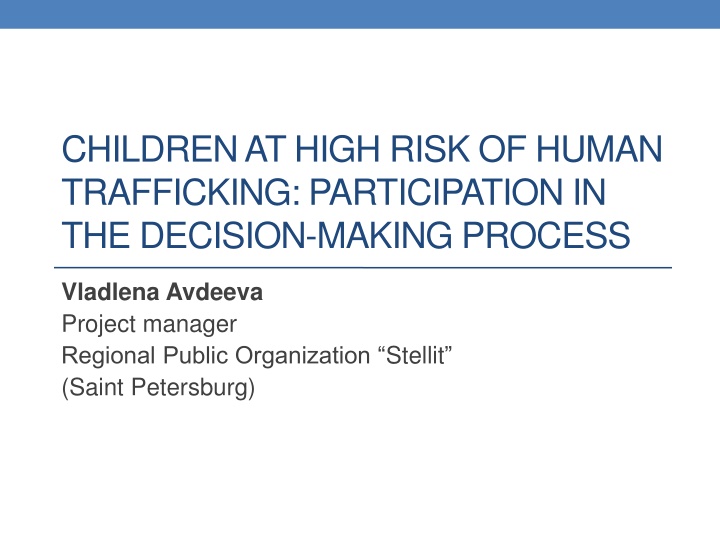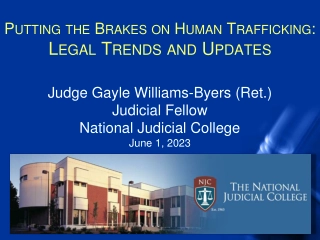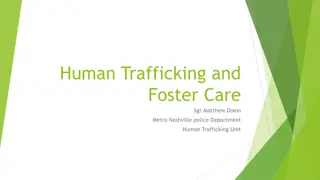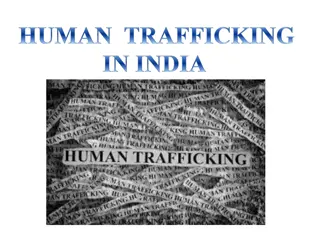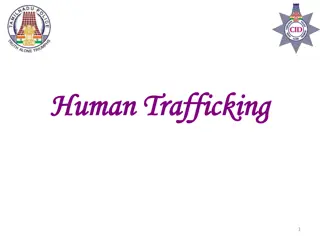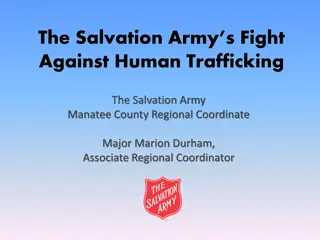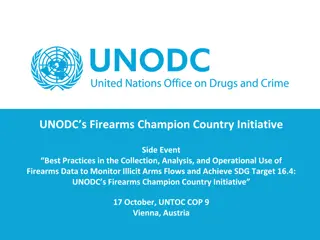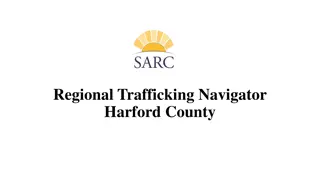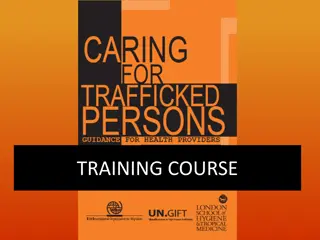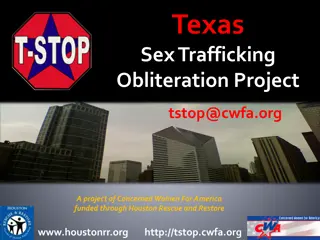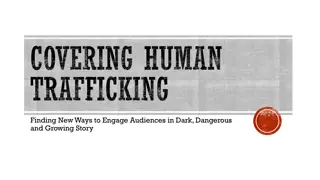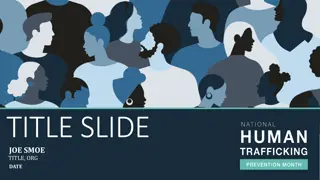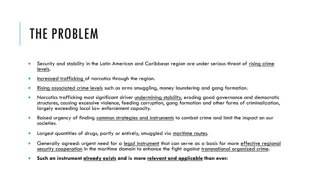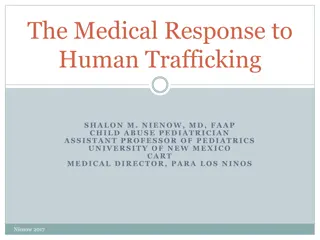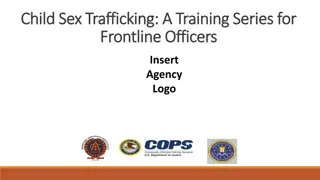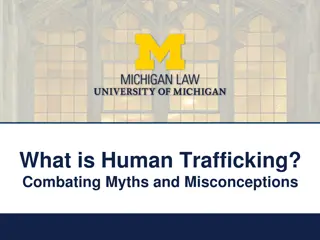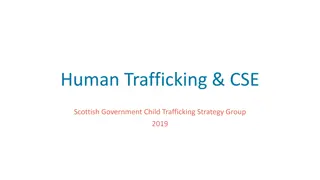Child Participation in Decision-Making Process for Combating Human Trafficking
Children are highly vulnerable to human trafficking, with millions of children being victims globally. Child participation in decision-making is essential, as it empowers children to express their views and be actively involved in matters that concern them. The legislative basis, including the Convention on the Rights of the Child, emphasizes the importance of considering children's views. However, there are challenges in achieving the goals of national strategies due to a lack of standardized monitoring. Efforts are needed to improve child participation to combat human trafficking effectively.
Download Presentation

Please find below an Image/Link to download the presentation.
The content on the website is provided AS IS for your information and personal use only. It may not be sold, licensed, or shared on other websites without obtaining consent from the author.If you encounter any issues during the download, it is possible that the publisher has removed the file from their server.
You are allowed to download the files provided on this website for personal or commercial use, subject to the condition that they are used lawfully. All files are the property of their respective owners.
The content on the website is provided AS IS for your information and personal use only. It may not be sold, licensed, or shared on other websites without obtaining consent from the author.
E N D
Presentation Transcript
CHILDREN AT HIGH RISK OF HUMAN TRAFFICKING: PARTICIPATION IN THE DECISION-MAKING PROCESS Vladlena Avdeeva Project manager Regional Public Organization Stellit (Saint Petersburg)
Children victims of trafficking According identified victims of human trafficking are children. In 2016 40 million people were victims of human trafficking, 10 million of them are children (according to the report of International Labor Organization and Walk Free Foundation). Refugee, migrant and displaced children are especially vulnerable to trafficking. Latent crime the number of child trafficking victims is higher than data presented in official statistics. to UNICEF data, approximately 28% of
Child participation in decision-making Child participation is an ongoing process of children s expression and active involvement in decision making at different levels in matters that concern them. (UNICEF: Child Participation). It requires information sharing and dialogue between children and adults based on mutual respect. Child participation is one of the CRC s four guiding principles alongside with non-discrimination; the best interests of the child; and life, survival and development.
Legislative basis for child participation Convention on the Rights of the Child, Article 12 States Parties shall assure to the child who is capable of forming his or her own views the right to express those views freely in all matters affecting the child, the views of the child being given due weight in accordance with the age and maturity of the child . National Strategy on Action for Children for 2012 2017. Section VII. Children as participants of the implementation of the National Strategy. The Decade of Childhood (2018-2027)
Achieving goals of the National Strategy onAction for Children There is no standard monitoring of child participation in decision making process, which does not allow to conduct a quantitative assessment and comparative regional analysis of this participation. According to qualitative assessment allows us to conclude that the expected results of the implementation of this part of the National Strategy and the principle of child participation in decision-making affecting their interests were achieved only partially.
Monitoring the Well-Being of Children in Formal Care Institutions Project objectives: developing and piloting methods and procedures to access the well-being and observance of rights of children left without parental care; analyzing the attitudes of children and adults to this assessment. Funding: Grant received Organization Stellit in accordance with the Decree of the President of the Russian Federation dated January 17, 2014 No. 11-rp and on the basis of a competition held by the Institute of Socio-Economic and Political Studies Foundation. by the Regional Public
Methods Guiding principles: Assessment of the well-being from child perspective. Children are the main source of information. Maximum coverage of children aged 10-17 years. Adapted survey methods for children. The maximum possible range of topics that are important for children. Methods: Survey among children (groups up to 10 children) and individual structured interviews (children aged 7-10 and children with developmental disorders) Observation conducted by the psychologists) Interviews with tutors and administration of the formal care institutions
Research project Social Trajectories of Children in Contemporary Russia Research purpose: assessment of the impact of child protection social institutions, family and behavioral factors on the life trajectories of children who are in contact with child welfare system. Sample: 113 cases. Each case is based on an interviews with a child, parent and social worker. Methods: focused interviews with children (from 10 to 17 years of age), parents or other legal representatives and specialists. Guiding principle: children as key informants of the research. Funding: Russian Science Foundation, project 16-18- 10372.
Consultations with children as experts Purpose of consultation with children and teenagers is collecting their ideas and recommendations on where to look for help and support in situations of abuse, exploitation and human trafficking, as well as on the components of an ideal shelter for children. Place: Shelter Transit (Saint Petersburg). Dates: 8 and 11 September 2017. Facilitators: psychologists of the shelter Transit . Participants: Group 1. 2 girls and 1 boy aged from 15 to 17, from Uzbekistan, Tajikistan and from Russia Group 2. 3 boys aged from 9 to 11, 1 from Russia, 2 from Tajikistan
Methods 1. Participants were asked to continue the story of a child who is separated from his or her parents, is living in a difficult and risky situation and is trying to leave this situation. 2. Children were asked to draw a picture of a safety map of a shelter for children: to discuss and define the main elements of the ideal shelter for children where children could feel safe, comfortable and so that they could find resources to overcome negative consequences of their past experience.
Results: Who can child talk to in order to get help? Parents Friends Other exploited children People in similar situation (e.g. those working at the same factory with the child) Police Shelter staff Medical workers Metro staff Taxi drivers Track drivers Strangers at the street (40-50 years olds) Clients of the factory shop Mass media Exploiter
Results: Where can a child seek help? Police Shelter Hospital Sleeping district of the city Park Shopping Center Church Metro station
Results: How the child could take care about him/herself? Ask someone for food Runaway and get home by foot/ hitch-hiking Find a job, earn the money, buy phone and get in touch with relatives Do something to attract attention of the police Runaway and sleep at cellars Team up with other children ask the exploiter to take them back home Hide the documents from exploiters or run away without documents Wait until parents find the child
Results: How can people recognize that the child is in difficult situation? Sad Has bruise, injuries Can hardly work Tired Walks back and force Spends free time alone
Results: elements of an ideal shelter (children aged 9-11) Place to play the computer Place to sleep Delicious food, including the possibility to eat in the KFC, Burger King, McDonalds Toys, board games, billiards, bowling, shooting gallery Clubs (camps), trainings (including beadwork, sports sections, theater studio, excursions) Washing machine, fridge Availability of mobile phone To be allowed to wear prettiest, child s own clothes, sandals, and not slippers The opportunity to meet bikers and learn to ride a motorcycle Pets corner with dogs, cats, and hamsters Opportunity to communicate with parents and other relatives To be allowed to go out with friends from 12 years Home school, where children could be taught to read Birthday gifts, e.g. a cake Gym, swimming pool, Jacuzzi Toilet where the door could be closed Clocks and an opportunity to learn the day of the week to know child s schedule and understand when he/she will be fed
Results: elements of an ideal shelter (children aged 9-11) Should be more male staff A kind cook who will bake buns Kind security guards Medical attendant, doctor Magician What kind of assistance should get a child: A child should tell his/her story, and the offender must be arrested
Results: elements of an ideal shelter (children aged 15-17) Isolator where doctors could check the health status of a child Soft beds Classes for children, taking into account age and interests Opportunity for children to participate in the household activities Availability of outdoor activities (museums, football, hockey games), trips out of the city, in other cities, children s camps. Separate places for boys/ girls/ small children and places where they could meet; small children should live in a separate place Girls need to be allowed to take care for the small children Opportunity to attend school The courtyard where children can go for a walk without a caregiver, whenever they want. It should be possible to walk there alone and think.
Results: elements of an ideal shelter (children aged 15-17) Place for the person to be alone, to cry, to beat a punching bag Dining room where you can help to cook and set the table Gym, training: swimming pool, box, judo, karate, wrestling, dancing The possibility of staging theatrical performances Room for costumes Dining room with sofas and TV Photo studio, audio studio, studio for editing Opportunity to play the game console, but there should be time limits Opportunity to call relatives and friends (so that everyone has the same amount of time for communication) Possibility to have pets
Results: shelter staff (children aged 15-17) Security guards Medical workers Psychologist Director PE instructor Tutor and psychologist who talk to children Handicraft teacher for boys, the seamstress for training of girls
Results: shelter staff (children aged 15-17) The staff members should be confident, should be able to tell the child the truth but to prepare for this information first Should take into account opinion of the child, his/her will to meet with parents Should allow a child to keep calm, cope with his/her emotions Should tell stories of other children so that the child so that a child could realize the possible consequences of his/her decisions, see different scenarios, and make the right decision Should respect the child and be able to explain everything in a calm way in case if a child does not understand anything, but should be strict at some extent Should treat all the children equally, should not have those whom they like more and whom they like less Should have a sense of humor
Results: types of assistance Accessibility (a child could come and leave at his/her own request) The shelter should be accessible both for children who have registration in St Petersburg and those who do not have Legal assistance Medical assistance
Conclusion According to the results of consultations with children, one of the most important characteristics assistance for children is taking their opinions into account and informing about the situation. The components of the "ideal" shelter for children include the opportunity to develop everyday skills and to have private space, as well as the opportunities for self- realization creative activities, sports, and education. Consultations with children as experts could be used in developing the preventive recommendations for professionals identification and rehabilitation of children suffered from abuse, exploitation and human trafficking. of providing programs involved and the in
Thanks for your attention Vladlena Avdeeva Project manager Regional Public Organization of Social Projects in Sphere of Population s Well-Being Stellit Website: ngostellit.ru Email: vladlena.avdeeva@gmail.com
